by Dagmara Genda // Feb. 7, 2023
This article is part of our feature topic ’FAMILY.’
The Bad Ideas Collective (BIC) is less of a working collective than a collection of artists sharing their “bad ideas,” though one of its three founders, artist and Central Saint Martins lecturer Marc Hulson, notes that it all depends on how one understands the word collective. If it is about “surrendering your identity to a concept,” he tells me in a conversation, then the term certainly fits. Hulson is referring to the condition of anonymity to which all artists agreed when they submitted their five-minute video exploring the notion of judgment. The resulting works are published online, though the name of the collective’s “members,” i.e. the contributors, are listed in the site’s “about” section. In each video, these semi-anonymous artists document or elaborate on a bad idea. Some of them even manage to make a good work of art in the process. The goal was, in the collective’s own words, to form “a speculative post art-world space where the ghosts of discarded possibilities…[are] cut loose from the moorings of authorship and value.” Yet the individual videos, and perhaps above all, their institutional actualisation as an exhibition at the Tallinn Art Hall, undermines this aim. There is a certain stickiness to value systems, especially as formed within the context of a close-knit community, that persist despite one’s best, or bad, intentions.
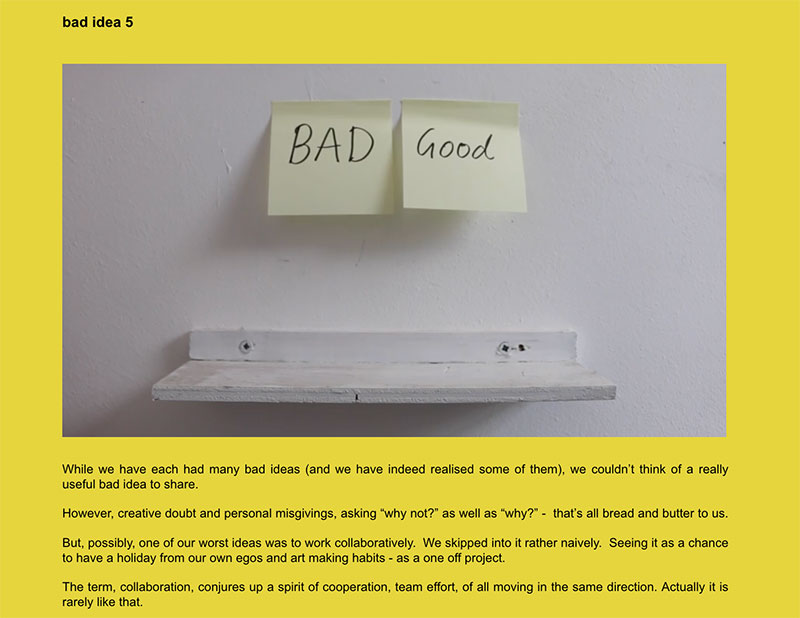
Bad Ideas Collective: www.badideascollective.com, 2023
It turns out that all the initial contributors not only know each other, but, as many are colleagues or former students at Central Saint Martins, are already on familiar terms. In the same spirit that christens the project a collective, I would say that their familiarity might even be stretched into the idea of family, or at least its Latin root familia, referring to the servants of the household. The house, in another historically grounded meaning, is that of academia. Because of its shutdown during the first COVID lockdown in 2020, it was reshaped into the house of the bad idea, to which each contributor, as Hulson notes, at least partially surrendered. What might seem like a fast and loose rhetorical glibness is in fact meant to highlight how value systems take shape through various forms of associations and that their relations are historically defined. Circles of familiarity lend structure, a quality that can act as an anchor when our usual moorings suddenly disappear.
Structure did indeed disappear during the first lockdown when the BIC founding members, Kristaps Ancāns, Marc Hulson and Alex Schady, were, like many artists, freed from the pressure of success only to be held hostage in a sort of existential limbo. Why keep making art? And how does one decide if the work is good or bad without the feedback of a larger art community? Already in a position where they made judgments on a daily basis, they finally had the opportunity to seriously consider how they have been making them and how they apply them to their own work.
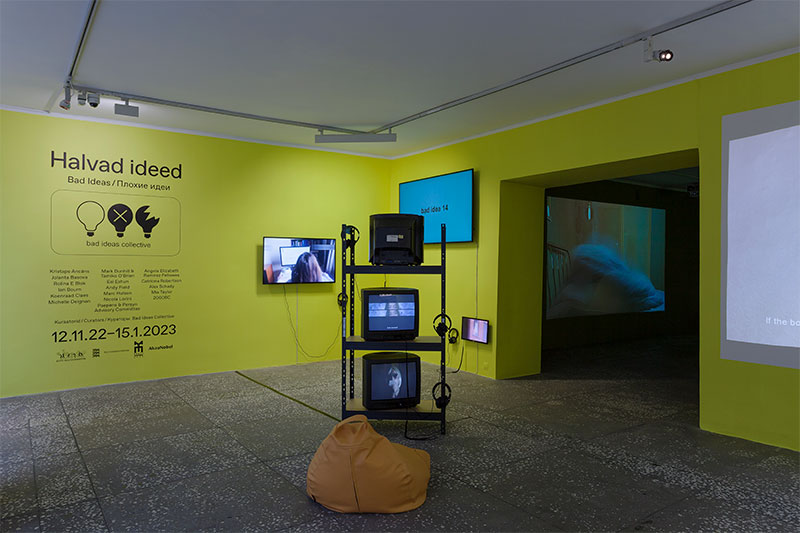
Bad Ideas Collective: ‘Bad Ideas’ at the Tallinn Art Hall, installation view, 2022 // Photo by Paul Kuimet
Since then, the collective’s bad ideas have been migrating back into the art world: first as part of a 2021 screening at Lethaby Gallery, London and, most recently, as an installation in the Tallinn Art Hall at the invitation of curator Corina Apostol. Titled ‘Bad Ideas,’ the yellow website is materialised into a similarly yellow room with text written on the walls alongside projected videos and variously installed monitors. Some of the bad ideas have made for quite thought-provoking works. Mark Dunhill and Tamiko O’Brien, whose contribution is also published elsewhere online under their real names, presented a playfully edited video collage wherein they contemplate the difficulties of longterm collaboration—a difficulty that may be connected to their own family status as a couple. The work features their established visual vocabulary of globs of wet clay and moving DIY gadgets, while a voiceover explains how collaboration doesn’t always produce good ideas but resembles something closer to sibling rivalry. Ego, competition and even delusion are expounded upon as the less glamorous aspects of long-term collective work, which may have also been the very things keeping the duo from completely “surrendering [its] identity to a concept.”
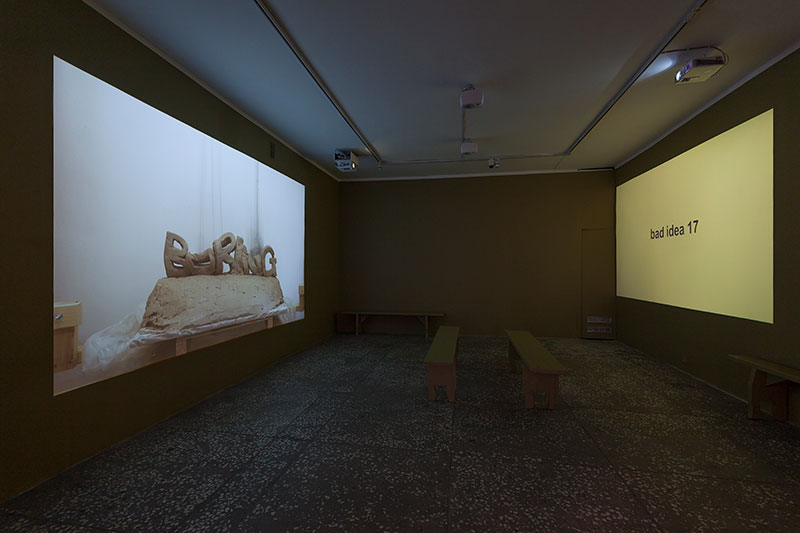
Bad Ideas Collective: ‘Bad Ideas’ at the Tallinn Art Hall, installation view, 2022 // Photo by Paul Kuimet
Other videos didn’t always tackle the notion of the bad idea, but used the constraints of the assignment as a catalyst for new work. In one piece, a man wearing a black medical mask holds a voice recorder to the camera from which a monologue plays. The recorded voice begins by comparing the family to a computer’s OS; it forms the basis for the software that is later installed in school. The quasi-confessional monologue is a series of disconnected memories that become engrossing in their literary execution. Other artists dwelled on the notion of the bad idea, while simultaneously enacting one on film. One piece features a child of about 10-years-old taped to a desk upon which an open laptop sits. The young girl is forced to read what are likely her father’s rambling musings on the bad idea. The video ends with the simple conclusion: “I prefer to make work without ideas.”
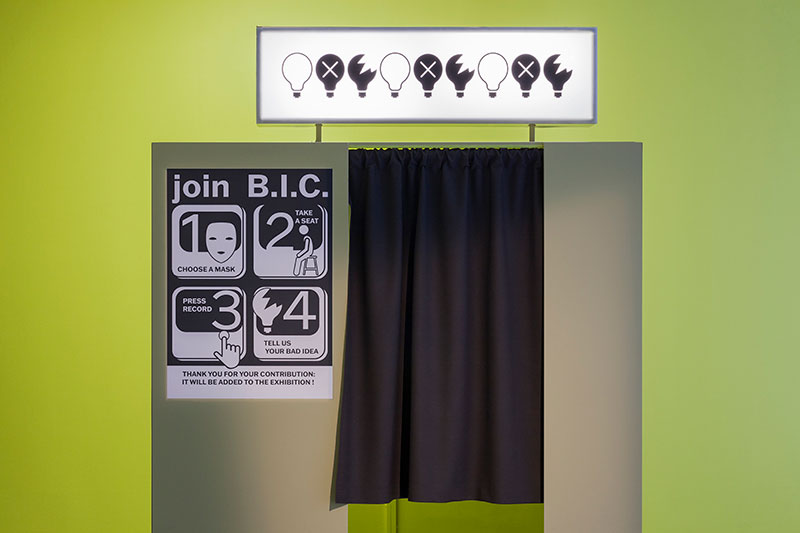
Bad Ideas Collective: ‘Bad Ideas’ at the Tallinn Art Hall, installation view, 2022 // Photo by Paul Kuimet
During a public talk with the collective at the Tallinn Art Hall, it strikes me that it isn’t the bad ideas we should necessarily be letting go of—no one is attached to them anyway—but rather, in the spirit of “killing your darlings,” the ones we think are good. The bad idea is a staple of the pedagogical system where students are encouraged to fail and even make art out of failure. Moreover, as the video by Dunhill and O’Brien suggests, there must be a sense of rivalry among such closely connected peers, mentors and mentees. Their familiarity was obvious from the heartfelt greetings, the waves and the tenor of the discussion, which was filled with anecdotes, occasional interruptions and even friendly teasing. In revealing and acknowledging the bad idea, one saves face by having made the critical judgment already. Putting aside the ego, as a number of artists said they did in this project, would entail surrendering ownership of one’s great ideas rather than the bad ones. In other words, the sharing of the bad idea created a compelling thought experiment and even good art, but left notions of value as informed by the academy and the reputation economy of the art world firmly intact.
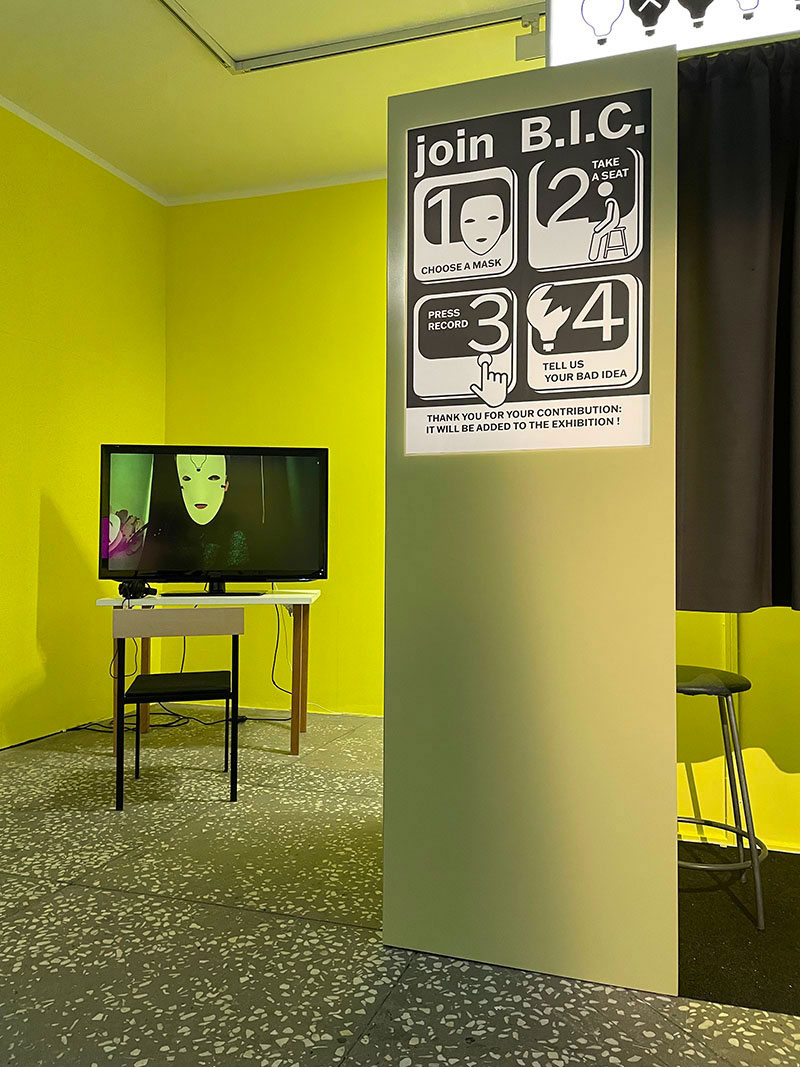
Bad Ideas Collective: ‘Bad Ideas’ at the Tallinn Art Hall, installation view, 2022 // Courtesy of the Bad Ideas Collective
If the familiarity of the collective members resulted in a safe space devoid of risk, it was the interesting inclusion of a “speaker’s corner” in the form of a video booth that brought a raw foreignness into the show. Visitors were invited to wear the BIC mask developed especially for the exhibition and recount one of their bad ideas. At the end of each day, the videos were cut into a compilation and shown on a monitor beside the booth. They ranged from the very serious to the absurdly comical. In one video, a group of four squeezes into the booth to announce that a very bad idea would be to kill their friend “Danny” on camera. Laughing, a woman yells “say goodbye Danny!” as she makes as if to punch him. In another video, a young, serious man with an Estonian accent ironically explains that a bad idea would be to teach critical thinking to children. The stylistic uniformity of the videos—a masked figure or figures filmed at very close range—lends them an unself-conscious believability, even if the atmosphere is reminiscent of a YouTube conspiracy theorist. Unlike the artists, the gallery visitors did not make aesthetic judgments in the making of their videos. Their contributions replicate the logic of the anonymous internet comment thread but embodied in a real person. Their opinions and stories pierced the familiar language of art as embodied by the videos. They also raised the question of how to foster values in a large anonymous population, as opposed to a small familial unit.

Bad Ideas Collective: ‘Bad Ideas’ at the Tallinn Art Hall, installation view, 2022 // Courtesy of the Bad Ideas Collective
If the family is indeed that which installs our operating systems, then the family of art workers is ultimately what decides if an idea is good or bad. It is this professional vocabulary of art that comes through in some very carefully crafted videos—a discursive performance that questions and critiques without necessarily exposing itself to criticism. However, this is not to say that the sharing of bad ideas is, well, a bad idea. A behind-the-scenes look into failed or unrealised plans and projects sheds light on just how much an artist produces that does not make it to the light of day. Moreover, it is perhaps the contrast between the artist and visitor contributions that made the latter doubly compelling and strange. In the end, this “post art-world space” of bad ideas returned to its home in the gallery, where the usual “moorings of authorship and value,” legitimised and even realised the “ghosts of discarded possibilities.”
Exhibition Info
Tallinn Art hall
Bad Ideas Collective: ‘Bad Ideas’
Exhibition: Nov. 12, 2022–Jan. 15, 2023
kunstihoone.ee
Project website: badideascollective.com
Vabaduse väljak 6, 10146 Tallinn, Estonia, click here for map
























